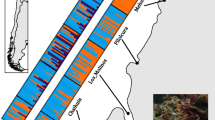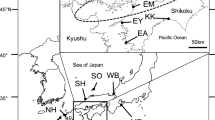Abstract
We describe three highly polymorphic microsatellite loci which have been isolated from the giant tiger prawn Penaeus monodon. The number of alleles present among 312 samples at the loci Pmo9, Pmo25 and Pmo27 were 84, 34 and 35, respectively, with heterozygosities all >90%. Analyses of the distribution of length variation at three microsatellite loci among five Australian P. monodon populations revealed strong differentiation between populations from the west and those from the northern and eastern coasts. Tests for population differentiation (F st) values and an analogous measure for microsatellite loci (R st) all demonstrated that Western Australian P. monodon are a separate genetic stock which exhibits reduced genetic variation relative to the other populations. Reduced variability is consistent with a recent population bottleneck or colonization by a small founding population from the east when sea links between Indonesia, New Guinea and Australia were re-established following the last ice age. The results of this study are in agreement with previous surveys of P. monodon conducted with allozymes and mtDNA.
Similar content being viewed by others
Author information
Authors and Affiliations
Additional information
Received: 18 December 1998 / Accepted: 27 August 1999
Rights and permissions
About this article
Cite this article
Brooker, A., Benzie, J., Blair, D. et al. Population structure of the giant tiger prawn Penaeus monodon in Australian waters, determined using microsatellite markers. Marine Biology 136, 149–157 (2000). https://doi.org/10.1007/s002270050017
Issue Date:
DOI: https://doi.org/10.1007/s002270050017




